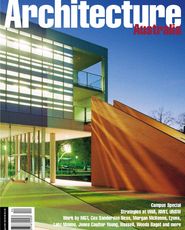Campus
The last few years have seen an architectural boom across Australia’s tertiary education institutions. Dramatic forms and surfaces enliven once-dreary suburban campuses, new landscapes reconfigure the public realm of middle-aged institutions, strong contemporary projects sit within traditional university settings, and bold insertions stud our cities. Abundant architectural awards index this flourish.
At the same time most institutions have experienced decreases in direct research and teaching funding – with a concomitant need to recruit full-fee-paying students – and increased class sizes. Institutions are also amalgamating, establishing satellite campuses, and sharing facilities with other kinds of educational providers.
And in the middle of all this, questions are posed about whether students and teachers need to be on site at all any more: are the buildings only there to be photographed for websites and brochures?%br% This architectural prosperity, then, coincides with a tightening financial situation, with new institutional configurations, and with ongoing rapid technological change. None of these are mutually exclusive events. As Peter Bickle points out in this issue, architectural patronage is not simply altruistic: it is based on economic determinants. But just as Bickle offers both a “cynical” and a “less cynical” account of RMIT’s “gemstone” strategy, so there are a number of readings of the phenomenon as a whole – readings which are also not mutually exclusive. Architectural patronage, institutional “branding”, and economic viability are irrevocably entangled. But architecture can also help academia negotiate this increasingly complex environment.
In this recent commitment to architectural distinction, particular contemporary circumstances overlay longer traditions. As a number of our reviewers observe, universities have a sound history of commissioning important and successful buildings and environments. The University of Western Australia, for example, obtained its signature building and landscape early. Newer universities also draw on this tradition, using architecture to signal their new status and to proclaim their “youthfulness” and their innovative approaches to research and teaching.
(The government’s white paper on research subsumes research into the broader category of “innovation”, an idea which can be more readily conveyed through iconic architectural structures.) Universities and TAFEs use similar strategies to court links with industry and commerce.
These projects can also be understood as interventions – in existing buildings, in existing campuses, in the urban fabric. The intended and real effects of these insertions vary widely, as does the amount of attention paid to the public realm. Some work carefully weaves buildings, landcape and public spaces together; other strategies result in fields of “signature” buildings jostling for attention. Some campuses operate as discrete private environments; others actively engage their broader landscape, be it urban, pastoral, or suburban.
This issue of Architecture Australia brings a series of projects and campuses into adjacency in the hope that this will generate broader speculations about the nature of this architectural boom, and will provide an opportunity to think beyond the individual architectural object.
The projects collected here provide a sample of recently completed work. Many more have been built and many more are planned or are under construction. A broad framework for discussion is provided by reviews of the architectural strategies of three quite different campuses – UWA, RMIT and UNSW. The reviews of particular projects raise different sets of issues and demonstrate different architectural responses. The specificity of these reviews reminds us of things that might be left out of broad-brush accounts. We are also reminded that architectural ideas have histories. For example, Steve Loo’s discussion of recent work at Adelaide University recalls Louis Kahn’s conception of the institution, and the commitment to the communal that this entailed – a commitment that may be too easily forgotten in the contemporary climate.















